FINISHING TOUCHES
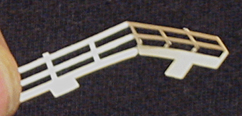 View the whole assembled model
View the whole assembled model
- From one Sheet BC, release a HANDRAIL. Bend the grid-like railing up 90 degrees from where it attaches to a thicker base with tabs. The thick base represents a narrow platform.
Now bend the piece in half, bringing the rectangular tabs toward each other. Pinch a crease in the middle of the railing.
- Position the HANDRAIL onto the front of the ELEVATION RING, straddling its front
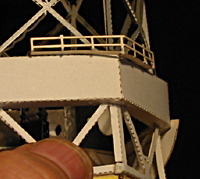 corner, and glue the two tabs down to the top of the ELEVATION RING. The narrow platform should not overlap onto the ELEVATION RING, but should just come in contact with it, so that it juts out away from the ELEVATION RING.
corner, and glue the two tabs down to the top of the ELEVATION RING. The narrow platform should not overlap onto the ELEVATION RING, but should just come in contact with it, so that it juts out away from the ELEVATION RING.
- Repeat with the other HANDRAIL on the other side of the ELEVATION RING.
+
+
+
+
+
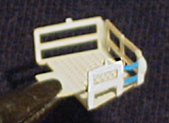
- From one Sheet BC, release both PLATFORMs. Fold up all the grid-like railings 90 degrees in the same direction.
Join the railings with a drop of glue where they touch. Make two mirror-image pieces, rather than exact duplicates.
- Glue the rectangular tabs of the PLATFORMs down onto the ELEVATION RING, positioning the PLATFORMs on either side of the central HANDRAIL just installed. The diagonal side of each PLATFORM should go on the outer side, away from the central HANDRAIL.
Join the railings of the PLATFORM and central HANDRAIL with drops of glue where they touch.
- Repeat with the two remaining PLATFORMs. Square up all the PLATFORMS and HANDRAILS neatly.
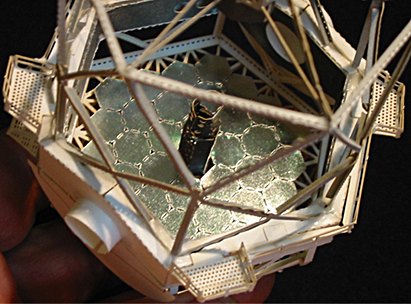
+
+
+
+
+
- Place the telescope on the pier, balancing it by setting the ELEVATION BEARINGS onto the apex of the PIER's large triangles. Adjust the telescope to a desired elevation angle and secure with glue at the elevation bearings, if you want it to be immobile. Otherwise, if you prefer the telescope to be free to rotate in elevation, don't glue it, and see below. Gluing the telescope to the PIER will make the whole assembly a bit more robust and stable.
- If you prefer to have the telescope remain movable in elevation, it may be necessary to add a little bit of weight near the top of the telescope tube. Test the balance by rotating the telescope from 0° elevation, pointing toward the horizon, up through 90° elevation, pointing straight up. If it does not balance well enough at lower elevations, drop some additional weight inside the SPIDER, where it will rest just above the SECONDARY MIRROR. Try objects of various weights, such as a small piece of cardboard, or even a small piece of metal such as a tiny nut or bolt. This counterweight should be sufficinet to make the telescope balance properly on the PIER at any elevation angle.
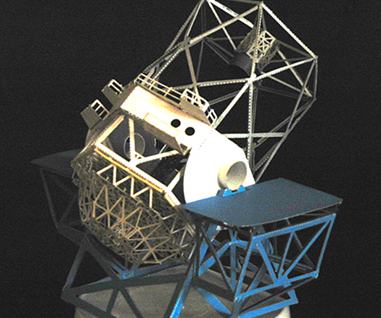
THIS COMPLETES YOUR KECK TELESCOPE MODEL.
View the whole assembled model
| ABOUT YOUR KECK TELESCOPE MODEL |
| SCI HOME PAGE |